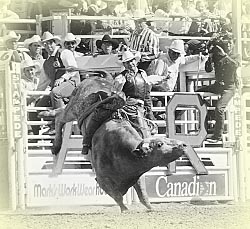|
Bull Riding A braided manilla rope is the cowboy's only security as he rides a wildly bucking brahma/cross bull. The rope is wrapped loosely around the bull and a weighted cowbell hangs underneath. When the ride is over, the cowbell pulls the rope free. The bull rider will be disqualified for touching the bull with his free hand or bucking off before the end of the eight-second ride. As it is tremendously difficult just to remain on top of these animals, riders are not required to spur. Bull riding, the most dangerous of all rodeo events, demands that a bullfighting clown be in the rodeo arena during each ride. As the cowboy is thrown from the bull, the bullfighter distracts the animal until the bull rider reaches safety. Professional bull riders know how to ride. They've been riding for years. When they get into trouble, it's like they say, "It's better to be safe than sorry", because they always have another bull to ride. In amateur rodeo, they try just as hard, but there's always the possibility of getting hurt. Richard Bish, Tsuu T'ina Nation, professional bullfighter, 1992
page 1 | page 2 | page 3 | page 4 | page 5 | page 6 | page 7 | page 8 Introduction | What makes Native Rodeo Different? | History of Rodeo Associations | Rodeo Heroes | The Rodeo Arena | The Rodeo Circuit | Rodeo Events | Down the Road SACRED BEINGS | RANCHING | ENTERTAINMENT | RODEO | ARTS AND INDUSTRIES |


